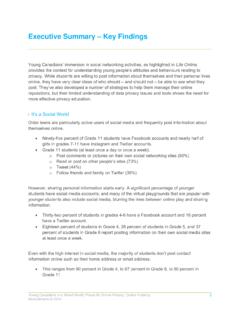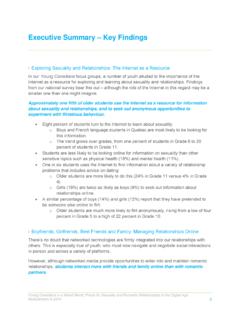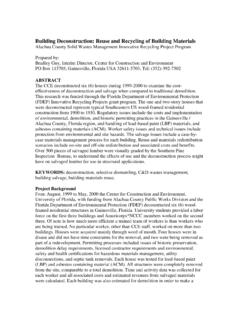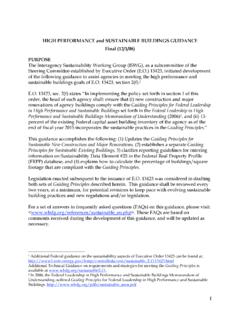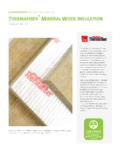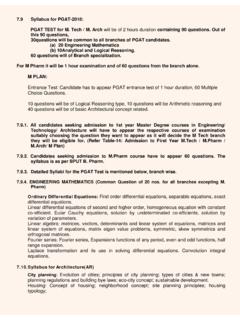Transcription of Lesson Beyond Media Messages Media Portrayal Global Issues
1 2012 MediaSmarts 1 Beyond Media Messages : Media Portrayal of Global Issues Level: Grades 7-12 About the Author: This unit was created for MediaSmarts by Media Educator, Maureen Baron. This Lesson was created with the financial assistance of the Canadian International Development Agency. Lesson PLAN Overview In this three-day unit, students assess Media coverage of natural disasters and their aftermath. Students explore how sensationalism plays a role in determining what is newsworthy, and how that can distort our perception of Issues in developing nations. What makes a story newsworthy? What positive results follow the natural disasters and how, where and when are those reported in the Media ?
2 How do distorted perceptions of developing nations affect our attitudes and behaviours toward them? As an extension activity, students may prepare a mock press conference in which they draw attention to reconstruction and recovery efforts following a natural disaster Learning Outcomes Students will demonstrate the ability to: articulate their views of developing nations define and recognize sensationalism, and identify it in news coverage demonstrate how news coverage influences our perception by focusing on particular aspects of developing nations use research and authentication skills to present a more complete picture of developing nations Activities Overview Day One: Our Perceptions of Developing Nations Activities a. Graphic representation of developing nations (30 minutes) b.
3 Definitions of developing nation and Global development, and class discussion (25 minutes) c. Reflection (20 minutes or homework) 2012 MediaSmarts 2 Beyond Media Messages : Media Portrayal of Global Issues Lesson Plan Grades 7 12 Day Two: Portrayal of Natural Disasters in Developing Nations Activities a. Defining how news is constructed (20 minutes) b. Research and deconstruction (40 minutes) c. Sharing the findings (15 minutes) Day Three: The Missing Picture Activities a. Researching and writing about what is missing (50 minutes) b. Reflection (25 minutes or homework) Extension Activity: Announcing Good News (one-day Lesson ) Activities a. Forming groups b. Creating an action plan c. Question and answer period d.
4 News conference Preparation and Materials Have on hand large sheets of blank paper, markers, lined paper, and tape or thumbtacks Arrange for access to computers or a computer lab with Internet connections Make available graphic organizers, from or Photocopy the following handouts: Defining a Concept News Deconstruction Chart (four copies for each group) Sensationalism Techniques Evaluation Evaluation should take place throughout the unit. Use the attached rubric to evaluate students on: the quality of their research their ability to recognize and identify sensational Media coverage 2012 MediaSmarts 3 Beyond Media Messages : Media Portrayal of Global Issues Lesson Plan Grades 7 12 their ability to recognize and identify gaps in Media coverage of developing nations their written reflection Procedure Day One: Our Perceptions of Developing Nations Graphic representation of developing nations Divide the class into five groups.
5 Ask each group to list words that represent ideas or images that they associate with the subject of developing nations. The group must make a graphic representation of their word associations by using a graphic organizer, such as a concept map, spider web, fishbone or flow chart. Ask students to consider and list places or sources where they encounter images of or information about developing nations. Definitions of developing nation and Global development Provide students with the following definition of the term developing nation : A country with a low standard of living, generally indicated by severe poverty, low income and education levels, high birth rate, and poorly developed social, economic, and technological infrastructure. PBS To make the concept more concrete to students, explain that many people in developing nations lack the basic amenities we take for granted, such as plumbing, clean drinking water, education, health care, and reliable electricity or public sanitation.
6 Stress that we use the term developing nation, and give some examples of nations that have advanced significantly in providing these amenities in different ways (South Korea in economic terms, India in terms of democracy, Bhutan in terms of transition to modernity, etc.). Also touch on the differences between the term developing nation and the older term third world : what negative stereotypes are associated with the older term? You may also wish to introduce the alternative term Global South and discuss why some people prefer it to both third world and developing nation. (A comparison of the various terms can be found at #Etymology.) What might be the advantages of each term? What is included in each and what is left out? Discuss with the class what might be meant by the term Global development.
7 What might be various aspects of Global development? (For example food aid, disaster relief, promoting women s rights, building infrastructure and ensuring access to clean water.) How can countries like Canada be involved in helping less developed nations become more developed? What types of people or organizations, other than governments, may be involved in Global development? (Examples might include individuals, non-governmental organizations, the United Nations and celebrities drawing attention to a cause.) Class discussion on perceptions of developing nations Direct the students to create, through class discussion, one graphic representation (in a format of the class s own choosing) to summarize the ideas discussed in class. During the discussion, guide the students to include how developing nations are represented in the Media and, in particular, how natural disasters in developing countries are portrayed.
8 2012 MediaSmarts 4 Beyond Media Messages : Media Portrayal of Global Issues Lesson Plan Grades 7 12 Reflection Ask the students to write a short response on the topic or aspect relating to developing nations that held the most associations for them. Have students identify why they selected this topic or aspect (a student might have roots or relatives in a particular developing nation, for instance, or might have been particularly affected by news coverage of a specific event). Day Two: Portrayal of Natural Disasters in Developing Nations Defining how news is constructed Explain to the students that you will be introducing and defining a concept relating to news reporting, by working together as a class and working backwards from examples.
9 Don t reveal the concept ( sensationalism ) being defined at the beginning if you are working with older classes. But for younger classes, provide the term to be defined at the beginning of the exercise. Distribute the Defining a Concept handout and explain that each of the 12 statements either is or is not an example of the concept you are defining. Do the first four for the class, and then ask students to guess together which of the next four statements are examples. Provide answers for each as you proceed, and then have students guess the last four privately. Ask students to share their guesses with the class and then give them the correct answers. Answer key: 1=YES, 2=NO, 3=NO, 4=YES, 5=NO, 6=YES, 7=NO, 8=YES, 9=NO, 10=YES, 11=YES, 12=YES.
10 Explain that the concept you have been defining is sensationalism. From these answers, ask the class what they know about the concept being defined: how are the sensational statements different from the non-sensational statements? (Answers should include the following: they make you worried, they are more exciting, and they present things as being more serious or important than they actually are.) Develop a brief definition of the concept with the class for students to write on the bottom of the handout. The final definition should be something like this one, which is from the New Zealand Broadcasting Standards Authority: Making a bigger deal about something (exaggerating) than is needed, in order to increase the audience s interest. Distribute the handout Sensationalism Techniques and review it with the class, looking at how the statements they discussed earlier are examples of different techniques.



